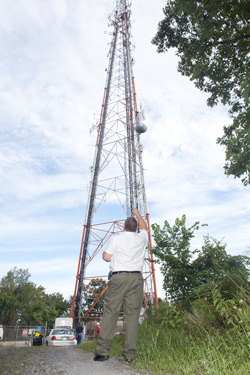 Mission Critical Partners‘ senior technology specialist Marty Klos is going on a ride-along with Zelienople police chief Jim Miller. But this isn’t some Elementary School deputy-in-training program. Miller and his squad are chasing down an elusive and mysterious perp who, if left on the street, could be deadly for officers in the field and dangerous for the citizens Miller is sworn to protect. The APB is out and the hunt is on. The target: radio interference.
Mission Critical Partners‘ senior technology specialist Marty Klos is going on a ride-along with Zelienople police chief Jim Miller. But this isn’t some Elementary School deputy-in-training program. Miller and his squad are chasing down an elusive and mysterious perp who, if left on the street, could be deadly for officers in the field and dangerous for the citizens Miller is sworn to protect. The APB is out and the hunt is on. The target: radio interference.
Started just 19 months ago, State College communications consultants Mission Critical Partners works with entities like the ZPD to connect first responders with emergency service dispatchers, making sure all communication devices and systems work as they should. With sensor equipment hanging out the window of a ZPD cruiser, Klos is conducting a process called radio sniffing; testing the air for static, cross-signals and sound interference preventing officers from communicating over the radio. Like storm-chasers, these dispatch detectives will search high and low around this rural Western PA neighborhood and they won’t stop until they slap the cuffs on this audible obstruction.
 “Police reach for the radio before they reach for their gun, firemen reach for the radio before the hose and EMS reach for the radio before the paddles,” says Klos, aiming a directional UHF antenna skyward. “It’s the most important piece of equipment they have.”
“Police reach for the radio before they reach for their gun, firemen reach for the radio before the hose and EMS reach for the radio before the paddles,” says Klos, aiming a directional UHF antenna skyward. “It’s the most important piece of equipment they have.”
As consumer communication technology has advanced rapidly, law enforcement and emergency communications have lagged behind, leaving many districts without a proper safety net for officers in the field. In an increasingly technological world, innovations like VoIP, instant messaging, and more reliable security cameras can allow police to be on the scene faster and arrive with better intel. But before these crime-stopping innovations can go to work, someone has to police the police so officers aren’t left wondering what button to push when push comes to shove.
“As more features and functions are offered, typically we are reducing it to ‘when I need to talk to somebody, this device will allow me to talk to somebody,'” says MCP Senior VP Brian Bark. “Officers are out there in the rain, in the dark, in the cold. They need it to just work in that emergency situation without a lot of thinking because the last thing you need to be worried about is ‘how do I make this device I am dependent on work.'”
It is important to get it right because if not, the results can be tragic. Last June in York, one Dover Township woman became the victim of a communication breakdown when her home and the home of her six children burned to the ground as initial text pages coming through the township’s $36 million 911 radio system failed to reach firefighters. Incidents like this haunt the nightmares of emergency personnel, causing many townships to get proactive before an incident can strike. That’s where companies like Mission Critical come in.
 “Our focus is to leverage varied technologies to develop redundancies so if one technology fails, it is integrated with another that will help support that operation” says Bark. “To be honest, some of the new technologies are not as reliable as the old copper wire systems. We are still developing the technology, which is why redundancy is so important.”
“Our focus is to leverage varied technologies to develop redundancies so if one technology fails, it is integrated with another that will help support that operation” says Bark. “To be honest, some of the new technologies are not as reliable as the old copper wire systems. We are still developing the technology, which is why redundancy is so important.”
Developing trustworthy technologies can take years. From the day the lightbulb above their head goes on, Pennsylvania’s dispatch detectives go through thousands of trials and remodels to make sure their system is working properly. For OnSite Information Systems CEO John Twigg, a 10-year journey began one April morning in 1999. That’s the day two students; Dylan Klebold and Eric Harris entered Columbine High School in Littleton, CO and began executing their classmates.
“The problem with Columbine was that the police waited four hours before entering the building and that delay was because they didn’t know the lay of the land,” says Twigg. “Had they gone in earlier, they could have maybe saved some lives.”
 Twigg’s children were enrolled in Plum Borough School District in suburban Pittsburgh and, after Columbine, school safety became the itch he couldn’t scratch. On his days off from his job designing document management software, Twigg spent five years designing and testing a program that would connect wireless laptops to school security cameras, integrating school blueprints with hallway views to give law enforcement professionals a 3-D eye in the sky. His company, now headquartered in Murrysville, Westmoreland County, presented the idea to the Plum school board. The system was quickly adopted and, within its first year, the school cameras caught the theft of an iPhone from a student’s locker. By cutting out the middle man, police were able to check the feed remotely, identify the guilty party and return the phone within 20 minutes of the reported incident.
Twigg’s children were enrolled in Plum Borough School District in suburban Pittsburgh and, after Columbine, school safety became the itch he couldn’t scratch. On his days off from his job designing document management software, Twigg spent five years designing and testing a program that would connect wireless laptops to school security cameras, integrating school blueprints with hallway views to give law enforcement professionals a 3-D eye in the sky. His company, now headquartered in Murrysville, Westmoreland County, presented the idea to the Plum school board. The system was quickly adopted and, within its first year, the school cameras caught the theft of an iPhone from a student’s locker. By cutting out the middle man, police were able to check the feed remotely, identify the guilty party and return the phone within 20 minutes of the reported incident.
Cutting out the middle man is important. Today, school security systems walk a fine line between protecting children and becoming an intrusive nuisance. In February, suburban Philadelphia’s Harriton High School made national news when the parents of student Blake Robbins filed a lawsuit against the school board. An off-campus incident brought to light that administrators were spying on students through school-issued laptop webcams without consent. School administrators claimed the cameras were installed as a security measure to prevent theft. But the resulting scandal, which involved an FBI investigation, ended the laptop program and caused many parents to think twice about where the line should be drawn when it comes to safety. After the Plum project, Twigg enlisted investment professional and former Plum school board member Jeff Russo to help manage the fears of parents and school boards across the state.
“When we did Plum, there were some parent concerns about big brother watching,” says Russo. “But this system is not used for daily monitoring. It is designed to be there when you need it and not when you don’t.”
 Since their success in Plum, other school districts and police departments have approached Twigg requesting further information. After acquiring a $100,000 federal grant from the Community Oriented Policing Services technology program, the Murrysville police department acquired the OnSite software and, in January, announced their partnership with the Franklin Regional School District to bring electronic eyes to the school hallways. Just like the Plum project, there was no incident that signaled a need for more security. Just a proactive school board and a town that can now rest a little easier knowing that these precautions are in place.
Since their success in Plum, other school districts and police departments have approached Twigg requesting further information. After acquiring a $100,000 federal grant from the Community Oriented Policing Services technology program, the Murrysville police department acquired the OnSite software and, in January, announced their partnership with the Franklin Regional School District to bring electronic eyes to the school hallways. Just like the Plum project, there was no incident that signaled a need for more security. Just a proactive school board and a town that can now rest a little easier knowing that these precautions are in place.
“If you look at the program itself, it puts the first responder in a proactive position when they are walking into a situation at the schools,” says Russo. “Giving this situational awareness helps improve response time to save a life or give them a better idea of where something could happen.”
Back in Zelienople, a long day on the streets is coming to a close. Klos has found the source of the interference and will be submitting a report and correcting the problem. Another day keeping communities safe from communication breakdowns has ended. And while they know crime never sleeps, Pennsylvania’s dispatch detectives are making sure that the electronic eye of justice is never caught napping.
John Steele is a freelance writer and blogger in Philadelphia. He enjoys music snobbery, trash television and laughing at hipsters. Send feedback here.
To receive Keystone Edge free every week, click here.
Photos:
The team from OnSite Information Systems updates the features on top of a school in Murrysville. Pictured (from left) are partners John Twigg and Jeff Russo, Mike Russo, Patrick Twigg and Bill Irwin.
Marty Klos, senior technology specialist for Mission Critical Partners, uses a directional UHF antenna to detect the direction and range of radio sources and looks for a rise in the noise floor.
Irwin working at the school in Murrysville.
Klos documents a radio tower as part of the troubleshooting process for the Zelienople Police Department.
Some red marks for the blueprint of the Murrysville school.
All Photographs by Renee Rosensteel
